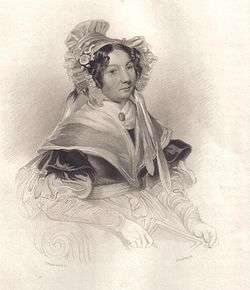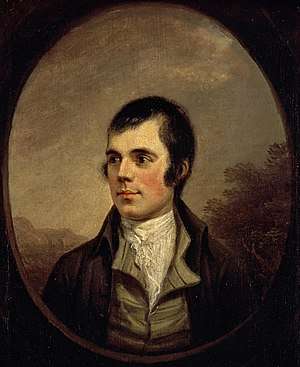Jessie Lewars
Jessie Lewars also known as Mrs. James Thomson,[1] was the youngest daughter of John Lewars, a supervisor of excise. Following the death of her 69-year-old father in 1789, Jessie was only 11 years old,[2] when she and her brother John moved to a house in Millhole Brae (now Burns Street) that lay opposite that of Robert Burns in Dumfries. Jessie was a close Burns family friend and when nearly at the age of eighteen helped the family by nursing Robert in the days leading up to his death and doing the domestic chores.[3][4]
Jessie Lewars | |
|---|---|
 Jessie Lewars | |
| Born | 1778 Dumfries, Scotland |
| Died | 26 May 1855 Maxwelltown, Scotland |
| Occupation | Housewife |
Life and character

Jessie had a brother and also an older sister, Mary, who married William Hyslop, a Dumfries builder.[5] As teasingly predicted by Robert Burns, Jessie married James Thomson, a lawyer or solicitor,[6] in Dumfries on 3 June 1799. The couple had five sons and two daughters. The sons were James (1800–1820); John (1802–1834), who worked with his father; William (1805–1858), who was a captain in the merchant service, and died at the Cape of Good Hope; Thomas (1810–1859); and Alexander (1814–1859.[5]
The elder daughter, Mary (1807–1843), married George Montgomery in 1840, a Dumfries merchant. They had a son, George, and a daughter, Jessie Lewars Montgomery. Jessie, younger daughter of James Thomson and Jessie Lewars, was born on 16 June 1816 and died unmarried in September 1877.[5]
Jessie lived in Dumfries at Maxwelltown, for the remainder of her life, dying at the age of 77 on 26 May 1855;[7] her husband, James Thomson, having died on 5 May 1849, aged 75.[4][8][9] Jessie and her husband were buried in a grave situated opposite to the Robert Burn's mausoleum in Saint Michael's churchyard, Dumfries.[4]
Association with Robert Burns and his family

John Lewars, Jessie's brother, was a colleague of Robert Burns in Dunfriesshire until his death in 1796[10] and gave official instruction to the Poet on his joining the service.[5]
Jessie not only nursed Robert Burns during his final illness, but also looked after his young family of four boys until his wife, Jean, had recovered from the birth of her last child, Maxwell Burns. Young Robert actually remained living with her for nearly a year.[4][11] Jessie played and sang to Robert whilst he lay in his sickbed, for Burns was rarely able to leave his room from April 1796, until his death in July of that year. She is said to have had a fine singing voice that Burns compared to a Linnet (Carduelis cannabina). He became very fond of Jessie and composed his very last song for her, namely "O wert thou in the cauld blast."[5] after hearing Jessie sing a popular song, known as "The Robin cam' to the Wren's Nest."; Felix Mendelssohn also set this to his own haunting music.[12] He also addressed to Jessie the song "Altho' thou maun never be mine."[4][13]
When she was briefly ill or indisposed Robert offered to write an epitaph to her on a crystal goblet, saying in jest "In case of the worst, Jessy, let me provide you with an epithaph":[9][14]-
|
He also wrote a rhymed toast to her on another crystal goblet containing wine and water using a diamond pen and requested that she regard it as a keepsake for life:[9]-[15]
|
Robert wrote the following tribute[9] to Jessie on the back of a menagerie handbill that she kept for the rest of her life: –
|
Jessie Lewars great granddaughter, Jessie Lewars Dove, inherited the handbill and it came back into the public sphere in Cambridge, around 1940. It was included as a reproduction in the 1940 Burns Chronicle.[16]
Burns also wrote to James Johnson in Edinburgh and requested a copy of "The Scots Musical Museum" for Jessie, saying "My wife has a very particular friend, a young lady who sings well, to whom she wishes to present the Scots Musical Museum, If you have a spare copy, will you be so obliging as to send it by the very first fly, as I am anxious to have it soon."[5] Johnson sent three, her copy being inscribed by the poet with a heartfelt expression of his appreciation for her kindness to him: -[15]
|
A thin quarto volume by Dr. Wolcott was given by Burns to Jessie, entitled Pindarinia, by Peter Pindar, 1794," in- scribed "Un petit gage de Vamitie. R. Burns." (a small token from a friend)[5]
After Burns's death it was John Lewars who wrote on behalf of Jean Armour Burns to several of Robert's close and intimate friends, such as James Burness in Montrose.[8] Jessie's friendship with Jean Armour Burns continued and she remained a support to the family, caring for the four small brothers.[17]
Micro-history
Jessie had her portrait painted by John Irvine.[8] At a festival held in honour of the poet's sons in 1844, Jessie was given pride of place next to Robert Burns' relatives.[8]
See also
- Jean Armour
- Alison Begbie or Elizabeth Gebbie
- Nelly Blair
- Jenny Clow
- Jean Gardner
- Nelly Kilpatrick
- Agnes Maclehose
- Ann Park
- Peggy Thompson
- Isabella Steven
- Robert Burns' diamond point engravings
- Kate Kemp
References
- Notes
- Westwood, Page 1
- Hill, Page 143
- Mackay, page 624
- Westwood (2008), Page 96
- The Book of Burns Retrieved : 1 August 2012
- Westwood (2001), Page 50
- Hill, Page 146
- Westwood, Page 174
- Douglas, Page 337
- Westward, Page 169
- Westwood, Page 75
- Dougall, Page 315
- Westwood, Page 171
- Adamson, Page 261
- Westwood,Page 173
- Purdie, Page 203
- Burns Scotland Archived 24 June 2007 at Archive.today Retrieved : 1 August 2012
- Sources
- Adamson, Archibald R. (1879). Rambles through the Land of Burns. Kilmarnock : Dunlop & Drennan.
- Dougall, Charles S. (1911). The Burns Country. London: A & C Black.
- Douglas, William Scott (Edit.) (1938). The Kilmarnock Edition of the Poetical Works of Robert Burns. Glasgow : The Scottish Daily Express.
- Hill, John C. Rev. (1961). The Love Songs and Heroines of Robert Burns. London : J. M. Dent.
- Mackay, James (2004). Burns. A Biography of Robert Burns. Darvel : Alloway Publishing. ISBN 0907526-85-3.
- Purdie, David; McCue Kirsteen and Carruthers, Gerrard. (2013). Maurice Lindsay's The Burns Encyclopaedia. London : Robert Hale. ISBN 978-0-7090-9194-3.
- Westwood, Peter J. (1996). Jean Armour. Mrs. Robert Burns. An Illustrated Biography. Dumfries : Creedon Publications.
- Westwood, Peter J. (2001). Jean Armour. My Life and Times with Robert Burns. Dumfries : Creedon Publications. ISBN 1899316-81-7.
- Westwood, Peter J. (2008). Who's Who in the World of Burns. Robert Burns World Federation. ISBN 978-1-899316-98-4.
External links
- "Print titled 'Mr.s Thomson, Jessie Lewars". Burns Scotland. 1820.